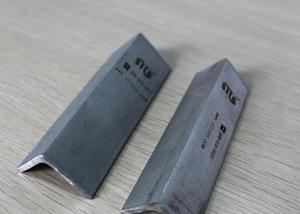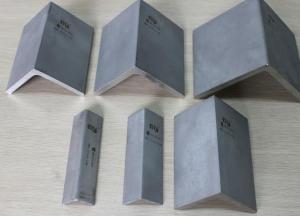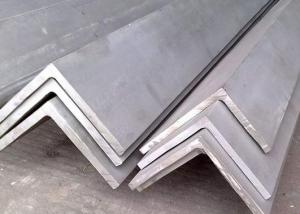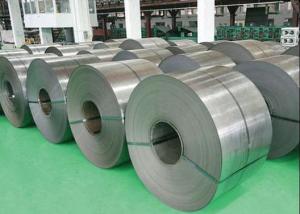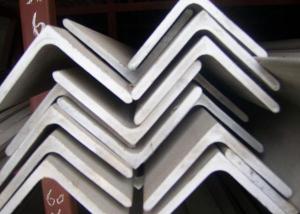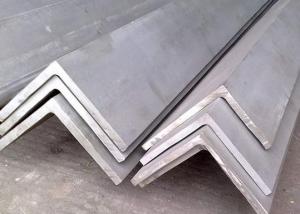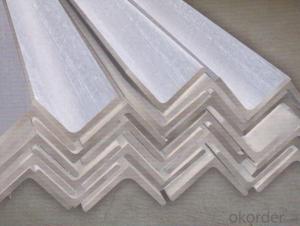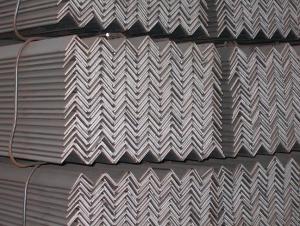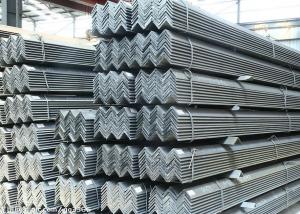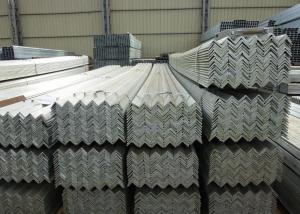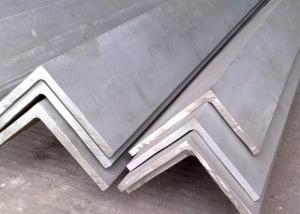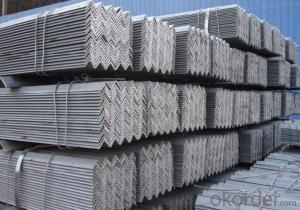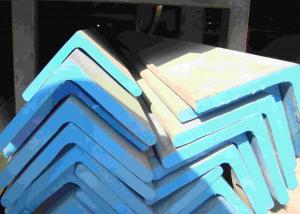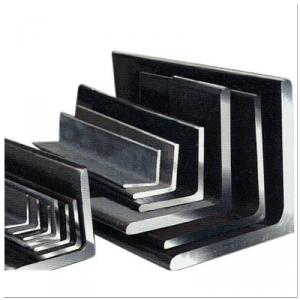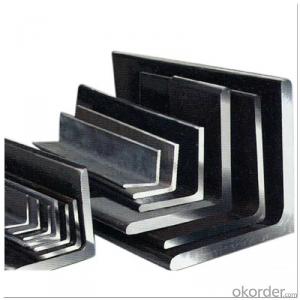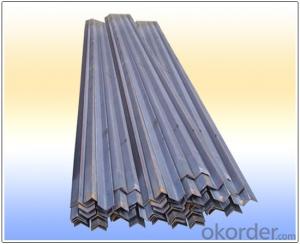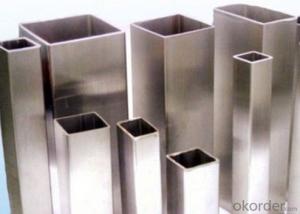Best Quality for Stainless Steel Angles
- Loading Port:
- China Main Port
- Payment Terms:
- TT or LC
- Min Order Qty:
- 1 Ton m.t.
- Supply Capability:
- 2000 Tons Per Month m.t./month
OKorder Service Pledge
OKorder Financial Service
You Might Also Like
Stainless Steel Angles
General Information of Stainless Steel Angles
1. Grade: SS200,300,400 series
2. Size: 25×25×3 mm-100×100×10mm
3. Process: HRAP
4. Length: 2-6m
5. Shape: Equal
6. Delivery: within 20 days
7. MOQ: 1 ton
8. Certificate: ISO 9001:2008, SGS
9. Package: Standard Export Packing, or put into wooden boxes according to your requirement
10. Application: Construction, Marine, Industry and so on.
Specification of Stainless Steel Angles
Name | Stainless Steel Angles | |||||
Standard | ASTM A554, A312, A249, A269 and A270 | |||||
Material Grade | 304,316,201,202, 316L,430 | |||||
Length | 6m or as customers' request | |||||
Tolerance | a) thickness: +/-0. 15mm | |||||
b) Length:+/-4. 5mm - 0mm | ||||||
Surface | 180G, 320G, 400G Satin / Hairline(Matt Finish, Brush, Dull Finish) 400G, 500G, 600G or 800G Mirror finish | |||||
Application | Decoration construction, upholstery, industry instruments | |||||
Test | Squash test, Extended test, Water pressure test, Crystal rot test, Heat treatment, NDT | |||||
Chemical Composition of Material | Composition Material | 201 | 202 | 304 | 316L | 430 |
C | ≤0.15 | ≤0.15 | ≤0.08 | ≤0.08 | ≤0.12 | |
Si | ≤1.00 | ≤1.00 | ≤1.00 | ≤1.00 | ≤1.00 | |
Mn | 5.5-7.5 | 7.5-10 | ≤2.00 | ≤2.00 | ≤1.00 | |
P | ≤0.06 | ≤0.06 | ≤0.045 | ≤0.045 | ≤0.040 | |
S | ≤0.03 | ≤0.03 | ≤0.030 | ≤0.030 | ≤0.030 | |
Cr | 16-18 | 17-19 | 18-20 | 16-18 | 16-18 | |
Ni | 3.5-5.5 | 4-6 | 8-10.5 | 10-14 | ||
Mo | 2.0-3.0 | |||||
Mechanical Property | Material Item | 201 | 202 | 304 | 316L | |
Tensile Strength | ≥535 | ≥520 | ≥520 | ≥520 | ||
Yield Strength | ≥245 | ≥205 | ≥205 | ≥205 | ||
Extension | ≥30% | ≥30% | ≥35% | ≥35% | ||
Hardness (HV) | <253 | <253 | <200 | <200 | ||

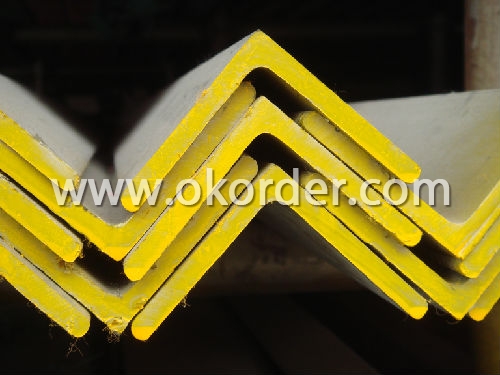
- Q: Can stainless steel angles be used in architectural applications?
- Yes, stainless steel angles can be used in architectural applications. They are versatile and durable, making them suitable for a variety of structural and decorative purposes in buildings, such as framing, supports, handrails, and trim. The corrosion-resistant properties of stainless steel also make it a preferred choice for exterior and interior architectural elements.
- Q: Are stainless steel angles available in different shapes?
- Yes, stainless steel angles are available in different shapes.
- Q: Are stainless steel angles resistant to atmospheric corrosion?
- Yes, stainless steel angles are known for their high resistance to atmospheric corrosion. Stainless steel is a type of steel alloy that contains chromium, which forms a thin, protective layer on the surface when exposed to oxygen. This layer, known as the passive layer, prevents further corrosion by blocking the contact between the metal and the surrounding atmosphere. As a result, stainless steel angles can withstand the effects of moisture, humidity, and various atmospheric pollutants without rusting or corroding. This makes them highly suitable for outdoor applications, such as construction, architecture, and marine environments, where they are exposed to the elements. Additionally, stainless steel angles can also resist corrosion from chemicals, acids, and other harsh substances, further enhancing their durability and longevity.
- Q: What is the melting point of stainless steel angles?
- The melting point of stainless steel angles can vary depending on the specific composition and grade of stainless steel being used. However, stainless steel typically has a higher melting point than other common metals such as iron or aluminum. The melting point of most stainless steel alloys can range from around 1370°C (2500°F) to 1425°C (2600°F). It is important to note that the melting point can vary slightly depending on the specific alloy and any impurities or additives present in the stainless steel.
- Q: How do stainless steel angles perform in acidic environments?
- Stainless steel angles are known for their excellent corrosion resistance, which makes them highly suitable for use in acidic environments. The presence of chromium in stainless steel helps to form a passive layer on the surface, which acts as a protective barrier against corrosive agents, including acids. This passive layer prevents further oxidation and degradation of the stainless steel, ensuring its durability and longevity in acidic conditions. In acidic environments, stainless steel angles exhibit minimal to no signs of corrosion, making them a reliable choice for applications such as chemical processing plants, wastewater treatment facilities, and food processing industries, where exposure to acids is common. The high resistance to corrosion also makes stainless steel angles suitable for outdoor applications, where they may be exposed to acid rain or other environmental factors. It is important to note that the performance of stainless steel angles in acidic environments can vary depending on the specific grade of stainless steel used. There are different grades of stainless steel available, each with its own composition and corrosion resistance properties. Therefore, it is essential to select the appropriate grade of stainless steel that suits the specific requirements of the acidic environment. Regular cleaning and maintenance are also necessary to ensure the optimum performance of stainless steel angles in acidic environments. Proper cleaning techniques and the use of compatible cleaning agents can help remove any contaminants or deposits that might compromise the passive layer on the stainless steel surface. Overall, stainless steel angles are an excellent choice for applications in acidic environments due to their superior corrosion resistance, durability, and ability to maintain their structural integrity even in harsh conditions.
- Q: What are the different types of stainless steel angle?
- There are several different types of stainless steel angles, including 304, 316, and 430. These types differ in their composition, with 304 being the most commonly used for general applications, 316 known for its increased resistance to corrosion, and 430 being a lower-cost option with less corrosion resistance.
- Q: Can stainless steel angles be used in the production of kitchen equipment?
- Indeed, kitchen equipment can incorporate stainless steel angles. The utilization of stainless steel in kitchen equipment is widespread owing to its commendable resistance to corrosion, sturdy nature, and attractive appearance. Stainless steel angles are adept at constructing the framework and providing structural support for a plethora of kitchen equipment including shelves, tables, countertops, and cabinets. These angles contribute to the equipment's stability and robustness, guaranteeing its durability and capacity to endure rigorous utilization within a kitchen setting. Moreover, stainless steel is easily cleaned and maintained, rendering it a sanitary choice for kitchen equipment.
- Q: Can stainless steel angles be used in sewage treatment plants?
- Stainless steel angles are indeed suitable for use in sewage treatment plants due to their remarkable resistance to corrosion and rust. This exceptional quality makes stainless steel an optimal material for applications in harsh and corrosive surroundings like sewage treatment plants. In these facilities, stainless steel angles are frequently utilized for multiple purposes, such as supporting structures, walkways, platforms, and equipment frames. The corrosion resistance and durability of stainless steel make it a cost-effective option for long-term usage in sewage treatment plants, where exposure to chemicals, moisture, and other corrosive elements is prevalent. Moreover, stainless steel is effortless to clean and maintain, ensuring that it complies with the hygiene standards of sewage treatment facilities.
- Q: Can stainless steel angles be used in the production of machinery frames?
- Yes, stainless steel angles can be used in the production of machinery frames. Stainless steel is a durable and corrosion-resistant material, making it ideal for applications where strength and longevity are required, such as machinery frames. The angular shape of stainless steel angles allows for structural support and reinforcement in machinery frames, ensuring stability and reliability in their operation.
- Q: How does stainless steel angle perform in abrasive environments?
- Stainless steel angle performs exceptionally well in abrasive environments due to its unique properties. Its high resistance to corrosion and oxidation makes it highly durable and suitable for prolonged exposure to abrasive materials. The chromium content in stainless steel forms a protective oxide layer on the surface, preventing the metal from being affected by abrasive substances. Additionally, stainless steel angle is known for its toughness and strength, which allows it to withstand the impact and wear caused by abrasive particles. This makes stainless steel angle a preferred choice for applications in industries such as mining, construction, and marine, where abrasive environments are common. Overall, stainless steel angle offers superior performance and longevity in abrasive conditions, making it a reliable and cost-effective material choice.
1. Manufacturer Overview
| Location | Zhejiang, China |
| Year Established | 2010 |
| Annual Output Value | above US$16 million |
| Main Markets | East Asia, Middle East. |
| Company Certifications |
2. Manufacturer Certificates
| a) Certification Name | |
| Range | |
| Reference | |
| Validity Period |
3. Manufacturer Capability
| a) Trade Capacity | |
| Nearest Port | Shanghai |
| Export Percentage | |
| No.of Employees in Trade Department | above 10 people |
| Language Spoken: | English, Chinese |
| b) Factory Information | |
| Factory Size: | about 30000 square meter |
| No. of Production Lines | above 7 |
| Contract Manufacturing | OEM Service Offered |
| Product Price Range | Average |
Send your message to us
Best Quality for Stainless Steel Angles
- Loading Port:
- China Main Port
- Payment Terms:
- TT or LC
- Min Order Qty:
- 1 Ton m.t.
- Supply Capability:
- 2000 Tons Per Month m.t./month
OKorder Service Pledge
OKorder Financial Service
Similar products
Hot products
Hot Searches
Related keywords


